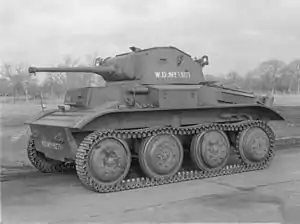
The Light Tank Mk VII Tetrarch was a British light tank produced by Vickers-Armstrong in the late 1930s and deployed during the Second World War. The Tetrarch was originally designed as the latest in the line of light tanks built by the company for the British Army. It improved upon its predecessor, the Mk VIB Light Tank, by introducing the extra firepower of a 2 pounder gun. The War Office ordered 70 tanks, an order that eventually increased to 220. Production was delayed by several factors, and as a consequence, only 100 to 177 of the tanks were produced. In early 1941, the Royal Armoured Corps formed three squadrons for use in overseas amphibious operations; one of which was equipped with Tetrarchs. In May 1942, a small number of Tetrarchs formed part of the British force which participated in the invasion of Madagascar, and, in June 1942, Tetrarchs were attached to the 1st Airborne Division after it was decided that the design allowed its use as an air-portable light tank to support British airborne forces. A lack of gliders prevented their participation in the Allied invasion of Sicily in 1943; instead they were attached to the new 6th Airborne Division and became part of the 6th Airborne Armoured Reconnaissance Regiment. The division used approximately 20 Tetrarchs during the British airborne landings in Normandy in June 1944. The tanks were successfully landed by glider, but they did not perform well. (Full article...)